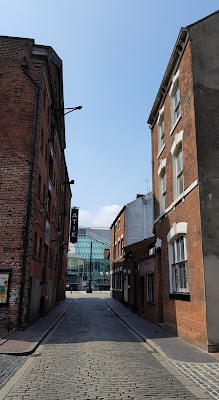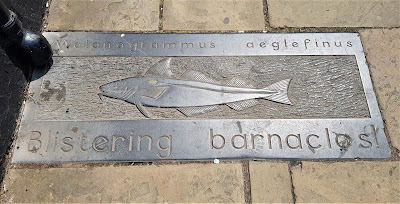Having wandered through the central shopping area, my first 'cultural' objective was the Ferens Art Gallery, housed in this modest building:
Then, sated, the galleries.
The Ferens Art Gallery had clearly been made into one of the main showpieces for Hull's 'City of Culture' endeavour. Some works, some paintings, had been borrowed from elsewhere (but then all municipal galleries do that to some extent), but the things on display were both striking and of high quality. Here's a sample of the portrait paintings, for instance.
The above pictures were ones that particularly caught my eye, and the more you look at them, the more you wonder what was really going on in the artist's mind. I've added the official notes fixed to the wall next to each work, which may help with the interpretation. (Click on these to enlarge)
The stream of quirkiness continued with a side-exhibition by a female artist who had photographed herself wearing latex facial replicas of her family, so that the picture wasn't really what it appeared to be. Here, for instance, she shot herself in a rubber replica mask of a dead uncle. His features, but her eyes. As intended, it looks realistic, but super-normal and not quite natural; intriguing and yet possibly disturbing.
Another 'City of Culture' photographic stunt was made much of: The Sea of Hull. Take one visionary photographer (Spencer Tunick), commissioned to create several eye-catching pictures of Hull. Add 3,200 co-operative nude residents, dyed either blue or green. Decorate the city centre with them. Say 'cheese' and take these amazing shots.
If you click on these shots, and look closely, you can see that all these people really are naked. Definitely not the British Thing! Even in 2016, when these pictures were made.
Well! Even though there's nothing wrong with my body-shape, skin, or lady-bits, I'm nevertheless a bit reticent about displaying my naked flesh - and I make no bones about it. I wondered whether - even in aid of a 'City of Culture' bid - I would be game enough to take off my kit and jostle with 3,200 other similarly nude people, however high-minded the occasion.
One of the Gallery staff told me about her twenty-something daughter's experience. Her daughter also had reservations, but, proud of her city, was determined to support this venture. And when it came to it, her embarrassment lasted only ten seconds. The presence of so many other people doing the same thing, for the same good reason, overcame her shyness, and she relaxed like everyone else had. And once covered in dye - she was one of the blue ones, I think the mother said - it was like wearing a very thin body-suit: somehow you felt clothed, even though all your nakedness was totally plain to see. There was a lot of hanging around - and that was rather chilly with nothing on - but as scene after scene was arranged, the feeling that you were doing something wonderful and important for Hull grew ever stronger, as did the sensation that you were taking part in a most unusual communal event that would be long remembered. In fact the Sea of Hull generated a boatload of useful publicity for the city.
Afterwards the daughter felt very proud to have taken part, very special. The only downside was that the dye proved difficult to wash off, and it took a few days to disappear entirely! But hey, it showed you had taken part, and were therefore a person of distinction - indeed, worthy of admiration.
I asked myself again: would I push myself into doing the same thing? Certainly not for Brighton, my nearest city, a place with its good points certainly, but it had never won my affections. Would I do it for somewhere else in Sussex, such as Chichester, or Lewes? I decided that I might, if the opportunity presented, and the cause was important. Which was an advance in personal attitude! I told myself that, as a member of a really big crowd of people, I would be anonymous and wouldn't be laughed at. Especially if I were as blue as a smurf. People wouldn't peer at my tummy, nor my boobs, nor stare lewdly. They would clap and cheer, and consider us all brave, and worthy of respect.
But don't hold me to this new-found loss of self-consciousness! It's temporary. In a few months' time, I may be more bashful, and less inclined to make a public statement, whatever the fine reason.
There was much else at the Ferens. Sculpture, for example, such as this.
And a fun corner with mirrors. Of course I couldn't resist experimenting!
No, I didn't do an encore with my clothes off...
Next, the waterfront. The old dock basins once extended into the heart of the old city. A big shopping and eating centre called Princes Quay had been built where boats had once moored.
The old buildings that had lined these docks were mostly still there - traditional pubs and so forth. And interesting-looking alleyways into what was now an artistic quarter.
In another part of the basin were a variety of old-time vessels: the former Spurn Head lightship (why painted black, instead of the usual red?), sailing boats, and sea-going barges. Plus the modern boats you can see in marinas everywhere.
It had turned into a gloriously sunny day. No wonder I was smiling!
The modern riverside had been reclaimed from a drab industrial past. It had once been full of dockside railway tracks, but very little of that remained now. Just a few vestiges, here and there, left in order to add period flavour, much as at Swansea.
I couldn't tell whether those brick road surfaces were original or not.
Here and there, metal plaques had been set into the ground, with fish typical of an old-time trawler catch on them, such as this one:
It was clear that most of the redevelopment had been in place for years past, and hadn't been hurriedly installed in the recent drive to become the 'City of Culture'. I wondered why then, if it had great shops, a smart city centre, and attractive riverside assets, Hull had for so long remained off the A-list (or even the B-list) of places the tourist might consider visiting, one of the last places you might consider for a weekend break. The city centre was no less historic or worth seeing than, say, the Barbican area of Plymouth. Or the city docks at Bristol. I readily admit that - if up in the North - it might be 'natural' to choose Liverpool over Hull, but really - setting aside Liverpool's compelling associations with the Mersey Ferry and The Beatles - there wasn't that much to choose between them. Well, I'm very willing to stand up for Hull.
The riverside walkways extended downriver, towards the sea, lined by handsome old maritime buildings.
The shoreline itself was, however, predictably brown and muddy, with no sign of any golden sand. The entire River Humber was brown, as if it were washing half the soil in East Yorkshire into the waiting sea.
That jutting, futuristic building is The Deep. It's a sea-life centre, one of Hull's major tourist draws. All of this area was once given over to dockland activities, but now some stylish regeneration had grown up - houses and offices.
While I like exciting modern architecture, I was more inclined - on this visit - to explore the older parts of Hull. So I turned into Dagger Lane - a rough and dangerous past history in that name, surely! - and made my way to the square on which stood the Minster. I saw several handsome buildings on the way.
And here was the Minster itself. Would you believe it: closed on the day I came! Tsk.
Oh well. Worth a few exterior shots anyway - and a reason to return to Hull.
That's not all I saw. Next post, or the one after that.


























































